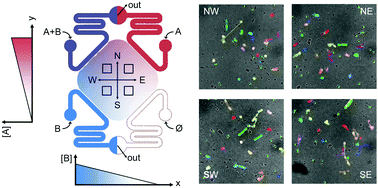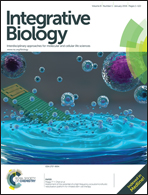A microfluidic dual gradient generator for conducting cell-based drug combination assays†
Abstract
We present a microfluidic chip that generates linear concentration gradients of multiple solutes that are orthogonally-aligned to each other. The kinetics of gradient formation was characterized using a fluorescent tracer matching the molecular weight of small inhibitory drugs. Live-cell signalling and motility experiments were conducted to demonstrate the potential uses and advantages of the device. A431 epidermoid carcinoma cells, where EGF induces apoptosis in a concentration-dependent manner, were simultaneously exposed to gradients of MEK inhibitor and EGF receptor (EGFR) inhibitor. By monitoring live caspase activation in the entire chip, we were able to quickly assess the combinatorial interaction between MEK and EGFR pathways, which otherwise would require costly and time consuming titration experiments. We also characterized the motility and morphology of MDA-MB-231 breast cancer cells exposed to orthogonal gradients of EGF and EGFR inhibitor. The microfluidic chip not only permitted the quantitative analysis of a population of cells exposed to drug combinations, but also enabled the morphological characterization of individual cells. In summary, our microfluidic device, capable of establishing concentration gradients of multiple compounds over a group of cells, facilitates and accelerates in vitro cell biology experiments, such as those required for cell-based drug combination assays.


 Please wait while we load your content...
Please wait while we load your content...